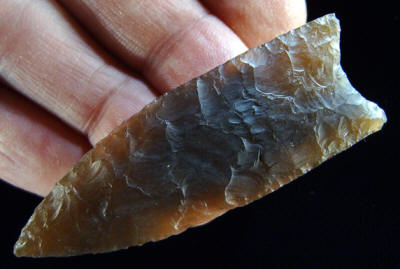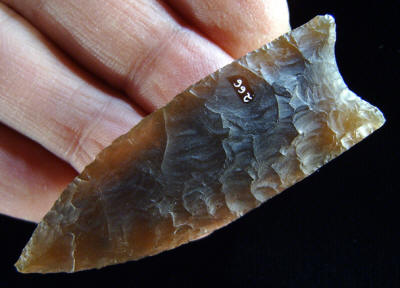|
GOSHEN
POINT
MILL
IRON
SITE
CARTER COUNTY, MONTANA

CAST ILLUSTRATED
CAST #P-82
GOSHEN
POINT
MILL IRON
SITE
CARTER
COUNTY, MONTANA
This Goshen point is described
by Frison and Bradley as a point that, "conforms in shape to the general
description of Goshen points." The hafting area edges on this point
(proximal edges) are straight but expand slightly towards the point (distal
portion). Pressure flaking on both sides was selective with a wide range of
flake scar widths. Pressure flakes on the base are not large enough to be
considered basal thinning. The material is not identified. This point
measures 2 1/2 inches (6.3 cm) long.
Thirty-one projectile points were found
on the Mill Iron site. Eleven were found in the camp area, twelve in the
bone bed meat processing area and seven points were found on the surface.
These points exhibit a fairly wide range of style and flaking technique.
Some of the bases are almost straight, while others vary from slightly to fairly deeply
concave, like this example. Also, some of the basal edges are concave but they are straight at the base of the concavity, similar to some Folsom
points. The sides are straight to slightly convex and one example
appears to be slightly fish-tailed. MILL
IRON SITE
The Mill iron site is
located in Carter County, Montana in the southeastern part of the state.
It's now believed that it represents the Goshen Cultural Complex as it was
described at the Hell Gap site in southeastern Wyoming. There are now five
accelerator dates on the site that average over 11,000 years before present.
It remains to be proven if Goshen is a Clovis variant or if it should be
placed somewhere between Clovis and Folsom.
The Mill Iron site contains a single component and is buried under 1.5
to 1.8 meters of sterile deposits. One area is a camp site meat processing
area and a short distance away is a bison bone bed that appears to be a
deliberate piling of articulated and disarticulated bones and is not an
actual kill area. Goshen projectile points demonstrate a wide range of
variation, much of which results from reworking of broken specimens. (Frison,
George C., 1991 pp 133-150)

CAST ILLUSTRATED
GOSHEN
POINT
MILL IRON
SITE
CARTER
COUNTY, MONTANA
Picture of opposite side
of point illustrated above, showing random flaking. |

